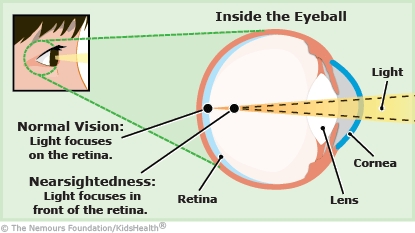Kids with nearsightedness (myopia) can see things better up close than far away.
In normal vision, light that reflects off an object enters the eye through the cornea and lens and focuses on the retina, at the back of the eye. The brain "sees" a clear image. In myopia, the light focuses in front of the retina, instead of directly on it. The brain "sees" a blurry image.
Glasses or contact lenses can help your child see clearly. Myopia may get worse during the teen years as the body grows a lot, so your child needs regular eye exams to check if they need different glasses or contact lenses. Myopia tends to change less in adulthood. Your health care provider can talk to you about things that may help slow the worsening of myopia.


Follow your health care provider's advice for:
Other tips:

Your child:
Call your health care provider if your child wears contacts and:

What are the signs of myopia? Kids with myopia have blurry vision when looking at things that are far away. They may also squint and blink a lot and hold books and toys closer to their face than usual.
Can eye surgery help with myopia? Eye surgery can help with myopia but only after a person's eyes are done growing and their myopia hasn't gotten worse in the past year. For most people, this is when they're 18–21 years old. The surgery, called laser refractive surgery, is done by ophthalmologists (doctors who treat eye problems) using lasers to change the shape of the cornea to correct the myopia.